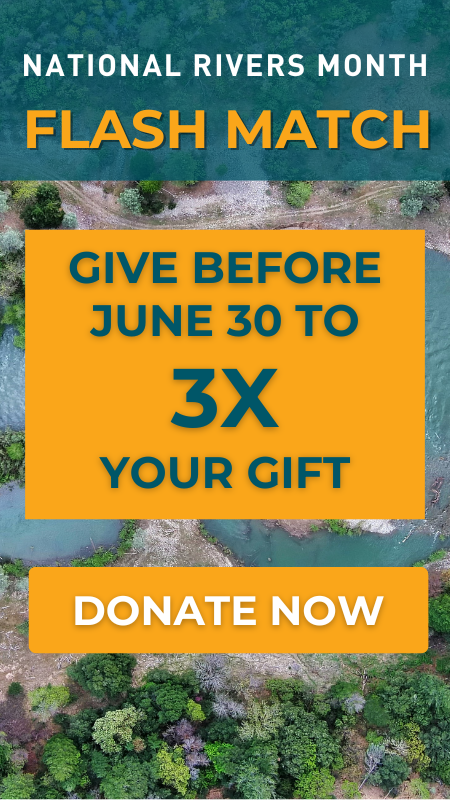Gila River Among America’s Most Endangered Rivers® of 2014
April 9, 2014
Contact:
(Washington, DC) – American Rivers named the Gila River among America’s Most Endangered Rivers® of 2014 today, shining a national spotlight on the threat that an expensive and unnecessary pipeline and diversion project poses to New Mexico’s last free-flowing river.
“The America’s Most Endangered Rivers report is a call to action to save rivers that are at a critical tipping point,” said Matt Niemerski of American Rivers. “It makes no sense to build an expensive and harmful diversion on New Mexico’s last free-flowing river when quicker, easier, and cheaper water supply solutions exist.”
Under a provision of the Arizona Water Settlements Act, construction of a large diversion project is planned on the Gila River that would capture an average of 14,000 acre-feet of water annually, or double the current withdrawals, to increase crop production and urbanization. Fortunately, cheaper, more cost-effective water supply solutions exist, such as municipal and agricultural conservation, effluent reuse, sustainable use of existing groundwater supplies, and watershed restoration.
American Rivers and its partners called on New Mexico Governor Susana Martinez to protect the Gila River and ensure that her Interstate Stream Commission implements cheaper and more effective non-diversion alternatives to meet southwest New Mexico’s water supply needs.
“Expert analysis has shown that the ISC’s proposal is fatally flawed and will not work as currently conceived,” said Allyson Siwik, Executive Director of the Gila Conservation Coalition. “The good news is that southwestern New Mexico’s future water needs can be met through non-diversion conservation alternatives that can be easily funded with the federal funding available under the Arizona Water Settlements Act. These measures, such as municipal and agricultural conservation, effluent reuse, sustainable groundwater management, and watershed restoration, can generate three times the amount of water at a fraction of the cost of an expensive and harmful diversion project.”
“A diversion on the Gila would be devastating to New Mexico’s natural heritage,” said Beth Bardwell, Director of Freshwater Conservation for Audubon New Mexico. “What’s at stake is the largest stretch of cottonwood-willow riparian forest remaining in New Mexico, one of the highest concentrations of breeding birds in North America, and a living river that supports outdoor recreation and tourism for rural communities.”
“Governor Martinez and the Interstate Stream Commission should do the right thing and reject the Gila diversion,” said Jason Amaro, New Mexico Wildlife Federation board member. “We need to maintain and enhance the health of the Gila River, the foundation of hunting and fishing related opportunities in southwestern New Mexico. By supporting conservation alternatives to diversion, New Mexico can satisfy its water needs while protecting the quality of this premier outdoor recreation destination and supporting local economies dependent upon river-related recreation.”
When asked in a June 2013 poll which approach they would prefer to address the state’s water situation, New Mexico residents overwhelmingly supported conservation-based alternatives to diversions. Eighty-five percent of residents support using current water supplies more wisely, by continuing to conserve water, using new technology to help reduce wasted water, and increasing recycling of water.
A tributary to the Colorado River, the Gila originates in America’s first designated wilderness area, the Gila Wilderness, and is rich in biological diversity and cultural history. The Gila River supports healthy riverside forests, cold water fisheries, and a remarkable abundance of wildlife. The river also provides significant economic value to the region with unparalleled opportunities for outdoor recreation, nature-based travel, and wilderness experience.
The annual America’s Most Endangered Rivers® report is a list of rivers at a crossroads, where key decisions in the coming months will determine the rivers’ fates. Over the years, the report has helped spur many successes, including the removal of outdated dams, the protection of rivers with Wild and Scenic designations, and the prevention of harmful development and pollution.
America’s Most Endangered Rivers® of 2014:
#1 San Joaquin River
California
Threat: Outdated water management and excessive diversions
At Risk: River health and resilient communities
#2 Upper Colorado River System
Colorado
Threat: New trans-mountain water diversions
At Risk: River health and recreation
#3 Middle Mississippi River
Missouri, Illinois, Kentucky
Threat: Outdated flood management
At Risk: Wildlife habitat and public safety
#4 Gila River
New Mexico
Threat: New water diversions
At Risk: River health, fish & wildlife, recreation, and tourism
#5 San Francisquito Creek
California
Threat: Dam
At Risk: Fish and wildlife habitat and public safety
#6 South Fork Edisto River
South Carolina
Threat: Excessive water withdrawals
At Risk: Fish and wildlife habitat, recreation, and water quality
#7 White River (CO)
Colorado
Threat: Oil and gas drilling
At Risk: Drinking water supplies and fish and wildlife habitat
#8 White River (WA)
Washington
Threat: Outdated dam and fish passage facilities
At Risk: Salmon, steelhead, and bull trout populations
#9 Haw River
North Carolina
Threat: Polluted runoff
At Risk: Clean water
#10 Clearwater/Lochsa Rivers
Idaho
Threat: Industrialization of a Wild and Scenic River corridor
At risk: Scenery, solitude, world-class recreational values
About American Rivers
American Rivers protects wild rivers, restores damaged rivers, and conserves clean water for people and nature. Since 1973, American Rivers has protected and restored more than 150,000 miles of rivers through advocacy efforts, on-the-ground projects, and an annual America’s Most Endangered Rivers® campaign. Headquartered in Washington, DC, American Rivers has offices across the country and more than 250,000 members, supporters, and volunteers.
Rivers connect us to each other, nature, and future generations. Find your connections at AmericanRivers.org, Facebook.com/AmericanRivers, and Twitter.com/AmericanRivers.


